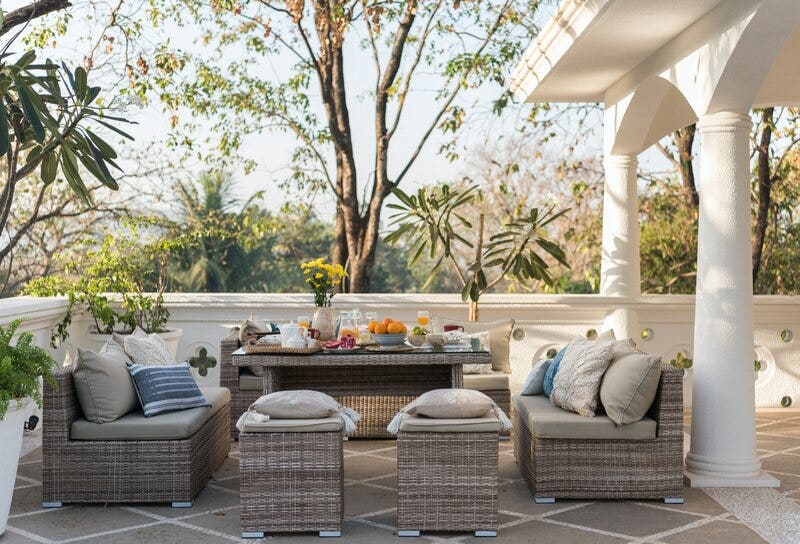
Patio Flooring Options: Which One Suits Your Style?
Introduction
Transforming your outdoor space into a relaxing oasis requires careful consideration of every element, including the flooring. With a wide range of patio flooring options available, selecting the one that complements your style and meets your functional needs is crucial. This comprehensive guide will explore the various materials, their advantages, and design considerations to help you make an informed decision.
Natural Stone
1. Granite
- Durability: Exceptionally hard and scratch-resistant, granite withstands heavy foot traffic and extreme weather conditions.
- Aesthetics: Available in a variety of colors and patterns, granite adds a touch of elegance to any patio.
- Maintenance: Requires regular sealing to maintain its beauty and prevent staining.
2. Limestone
- Versatility: Limestone offers a wide range of colors, from warm beige to cool gray, making it suitable for various design styles.
- Slip-resistance: The textured surface of limestone provides excellent traction, even when wet.
- Maintenance: Requires occasional cleaning and sealing to preserve its appearance.
3. Travertine
- Unique Appearance: Travertine features natural holes and veins that create a distinctive and charming look.
- Warmth: The porous nature of travertine absorbs heat, making it a comfortable choice for barefoot walking.
- Maintenance: Requires regular cleaning and sealing to prevent staining and water damage.
Concrete
1. Stamped Concrete
- Design Flexibility: Stamped concrete can be molded into various patterns and textures, allowing for customization.
- Durability: Properly installed stamped concrete is highly durable and can withstand heavy use.
- Maintenance: Requires periodic cleaning and sealing to maintain its appearance.
2. Pavers
- Versatility: Concrete pavers come in a wide range of shapes, sizes, and colors, providing endless design possibilities.
- Easy Installation: Pavers can be installed over existing surfaces, making them a convenient option for renovations.
- Maintenance: Requires occasional cleaning and re-sanding to keep joints stable.
Wood
1. Pressure-Treated Lumber
- Affordability: Pressure-treated lumber is a cost-effective option that provides a natural wood look.
- Durability: Treated with chemicals to resist rot and insects, it offers moderate durability.
- Maintenance: Requires regular cleaning, staining, and sealing to maintain its appearance.
2. Redwood
- Natural Beauty: Redwood has a rich, reddish-brown color that complements any outdoor setting.
- Durability: Naturally resistant to decay and insects, redwood offers exceptional longevity.
- Maintenance: Requires occasional cleaning and sealing to protect its natural beauty.
Composite
1. PVC Composite
- Low Maintenance: PVC composite requires minimal cleaning and maintenance, making it a convenient choice.
- Durability: Highly resistant to moisture, rot, and insects, ensuring long-lasting performance.
- Aesthetics: Available in a variety of colors and textures, PVC composite mimics the look of natural wood.
2. Wood-Plastic Composite (WPC)
- Environmental Sustainability: WPC is made from recycled wood fibers and plastic, reducing its environmental impact.
- Durability: Offers moderate durability, resisting moisture and insects.
- Aesthetics: Provides a natural wood appearance, but may fade over time.
Other Options
1. Brick
- Classic Appeal: Brick adds a timeless charm to any patio, creating a cozy and inviting atmosphere.
- Durability: Brick is extremely durable and can withstand heavy use.
- Maintenance: Requires occasional cleaning and repointing to maintain its integrity.
2. Porcelain Tile
- Sleek and Modern: Porcelain tile offers a sleek and modern look, complementing contemporary design styles.
- Durability: Highly durable and resistant to moisture, scratches, and fading.
- Maintenance: Requires regular cleaning and occasional sealing to maintain its appearance.
3. Rubber Flooring
- Comfort and Safety: Rubber flooring provides a soft and comfortable surface, making it ideal for barefoot walking.
- Durability: Highly durable and resistant to wear and tear.
- Maintenance: Requires occasional cleaning to remove dirt and debris.
Design Considerations
1. Style: Choose a flooring material that aligns with the overall style of your patio and home. Natural stone and wood offer a classic and elegant look, while concrete and composite provide a more modern and contemporary aesthetic.
2. Climate: Consider the climate in your area when selecting flooring. Materials like granite and porcelain tile are suitable for extreme weather conditions, while wood and rubber flooring may require more maintenance in harsh environments.
3. Traffic: The amount of foot traffic your patio receives will influence the durability of the flooring. Granite and concrete are excellent choices for high-traffic areas, while wood and composite may be more suitable for lighter use.
4. Budget: Patio flooring materials vary in cost, so it’s important to set a budget before making a decision. Natural stone and porcelain tile are typically more expensive, while concrete and composite offer more affordable options.
Conclusion
Choosing the right patio flooring is an important decision that can enhance the beauty and functionality of your outdoor space. By carefully considering the various materials, their advantages, and design considerations, you can select the perfect flooring option that complements your style, meets your needs, and creates a welcoming and inviting oasis for years to come.